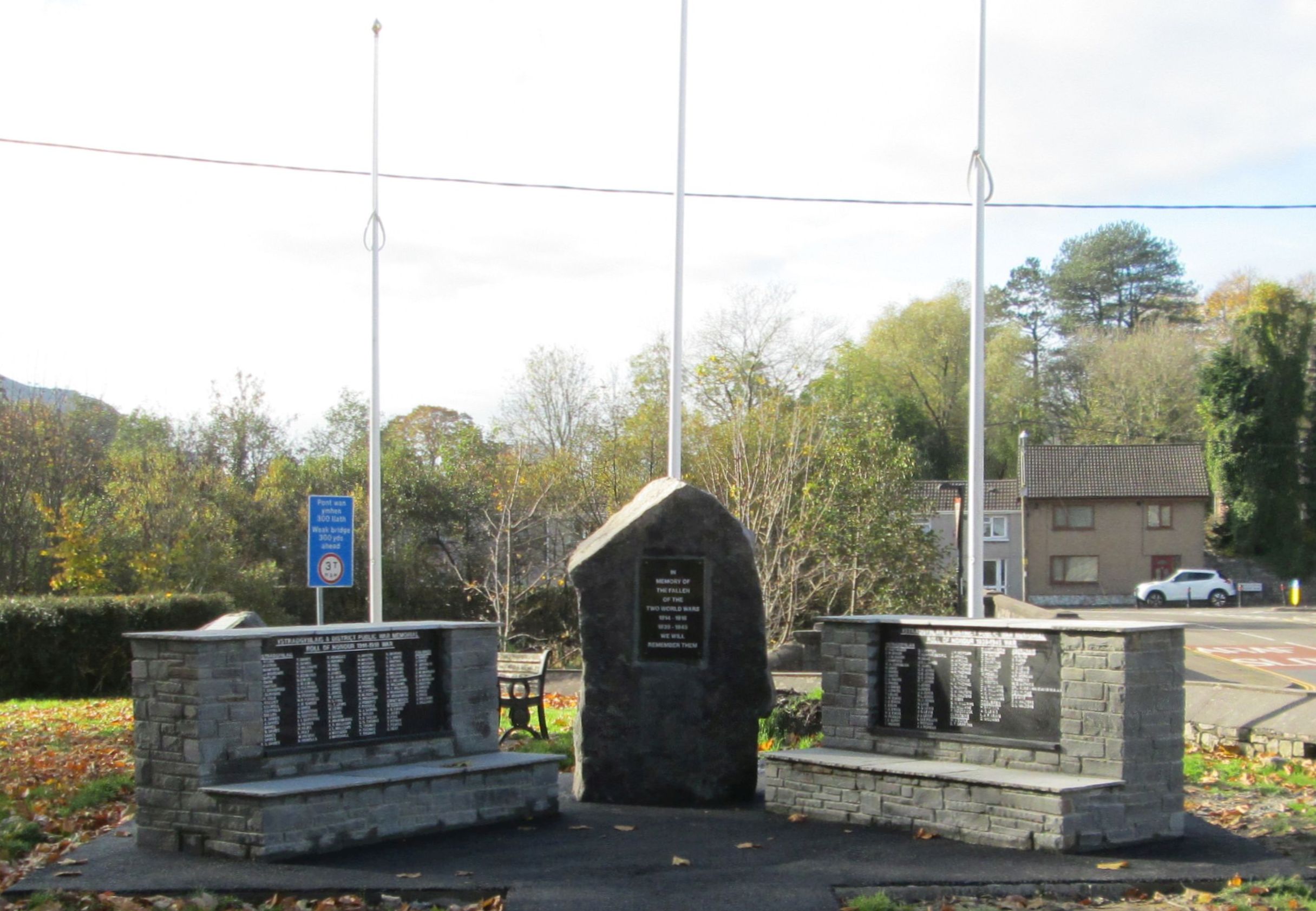Ystradgynlais & District
History and Heritage
William Watkins - Watkins y Stiward
The South Wales Voice newspaper for Friday 16th October 1953 included another article by local historian Mr D Watkin Morgan of Abercrave. This article is on William Watkins of Abercrave, otherwise known as Watkin y Stiward, a man who was one of the great mining engineers of the Swansea Valley in the late 19th century. William's father Thoms Watkins had been one of the founders of Tynycoed Chapel, and after his retirement William was to be strongly associated with the chapel, where his family grave can be found.
THE STORY OF A GREAT SWANSEA VALLEY MINING ENGINEER
With the birth of industry at Abercrave appeared a local boy who was destined to become one of the great mining engineers the Valley has known. He was William Watkins or Watkins 'Y Stiward' as he was popularly known. The story of the beginnings of industry in the village is incomplete without a brief account of this man but in order to do this, one must go beyond the confines of the valley itself to Carmarthenshire.
In the villages of Llanon and Llanboidy of that county there lived Thomas Watkins and his wife. Thomas earned his living as a kind of overseer over some property owned by the Gwyn family of Neath but when members of this family moved, he was invited to continue the same kind of work in the upper reaches of the Tawe and in a short time they were living at Gwarscwd, a little thatched cottage on the banks of Nant Elen. Gwarscwd no longer exists. It was demolished in later years and replaced by Dryalwyn, a more up-to-date house.
Coming to live in the locality, Thomas associated himself with a small band of Nonconformists and through his influence with the Gwyn family he was instrumental in obtaining land to build the ancient edifice of Tynycoed in 1777. He also became its first secretary. From the large family he brought up William, who was born on 26th June 1782, was the most outstanding child.
As a boy young William worked on the patches of iron ore and later at the Gwaunclawdd level. Those were the days when education was the prerogative of the rich, but the little that was available locally in the circulating school of Gruffydd Jones of Llanddowor at Maes y Fron Farm was taken advantage of. Through an innate desire for knowledge and a creative mind he soon learned to read and write both in English and Welsh and in a short space of time attracted the attention of William Shaxby who lived at Tir Mawr, where stand the stables of the present Ty Mawr. At the same time Daniel Harper lived at Glyn Mawr, known today as Abercrave House. When William was a young man, Jackson appointed him steward or manager of the colliery.
Not only was William Watkins in favour with his employers, Shaxby's adopted daughter, Rachel, had also captivated is attention. By 1806 he had completely won her heart and from then on he lived with his father-in-law. From this union six children were born, descendants of whom, are very numerous at Abercrave. On the death of his father-in-law in 1840 he inherited the estate but then sold it to Walters of Swansea. Afterwards he built the present house of Ty Mawr and named it 'Coalbrook'.
As a mining engineer he was William Shaxby's right-hand man and was the chief architect of all his ventures. Whatever project was envisaged, Watkins was consulted and afterwards he put it into operation. Relations with the miners were most intimate and friendly. Any dispute was settled that day at some inn, in an amicable manner. The early success of those days was due to the active cooperation between him and the miners. It is said that he always discussed any proposed improvement with the workers and would ask for their help. It was not the case of master and servants but rather that of a captain and his team.
Strange, but true, it was after retirement that he became a member of Tynycoed Chapel although he had always been regular at all chapel meetings. When he severed his connection with the coal, he devoted his whole time to helping the poor and promoting the religious life of the community. There had been no change of outlook but rather a stronger desire to serve his fellow men. Even during his management coal was stocked on the yard when transport failed owing to the canal being frozen up in winter. This ensured regular employment.
Many are the sidelights on his character. His home was open day and night to any Nonconformist minister; the only condition for residents was that a sermon had to be delivered. Hundreds of sermons have been given at Ty Mawr. Devotional meetings were held every week at his house and also a Sunday school. On one occasion some old miner while at prayer was ruthlessly interrupted with the words, "Pray from the heart man and not from the head".
On another occasion, while returning from Tynycoed in the company of his pastor, Robert Lewis, he was heard to ask, "If a man dies in the morning, how long would it take to reach heaven?"
"Well Mr Watkin, I am sure will be there before nightfall" was the reply.
Watkins 'Y Stiward' was respected by all, while he reciprocated through his charitable disposition, example and way of life.
He died in 1863 at the age of 81 and in his will he left £400 to Tynycoed but this was lost in later years. Bethlehem, the plans of which he himself had drawn up, received £200 part of this also disappeared in a similar manner. To Nantyffin was given £200. In addition the London Missionary Society and British and Foreign Bible Society were also benefactors. He was survived by 6 children as well as many brothers.
William Watkins was one of the great pioneers of the early decade of the 19th Century. His name will never be obliterated from the annals of the local history of Abercrave. His mortal remains lie buried half way up on the right hand side of the path that leads to the chapel of Tynycoed, which he loved so much. He and his team of workmen were as one.
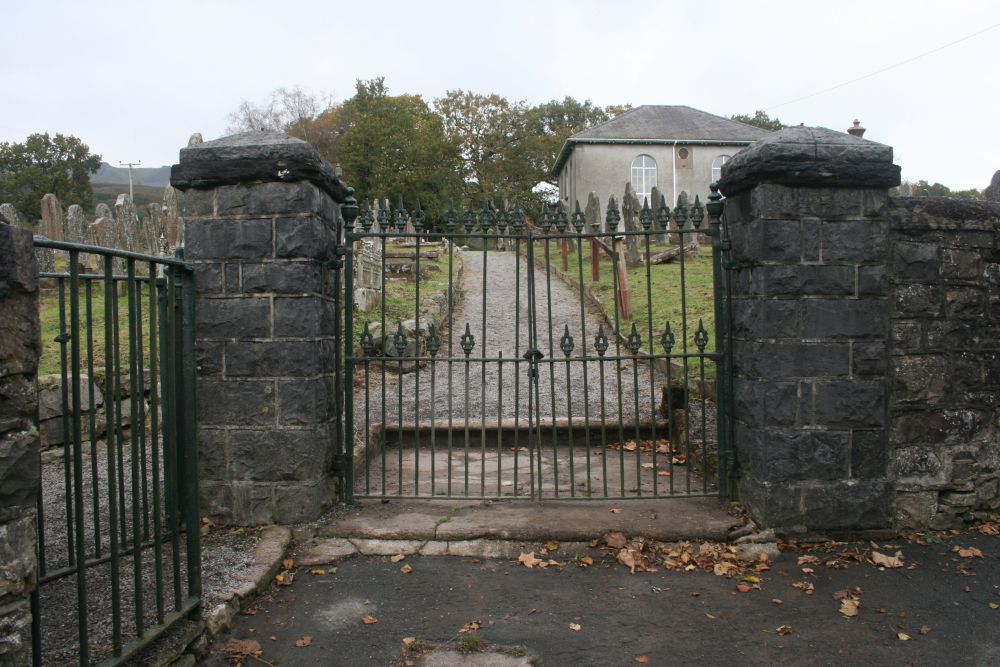
The gate to the cemetery and chapel at Tynycoed, near to Abercrave and Ynyswen.
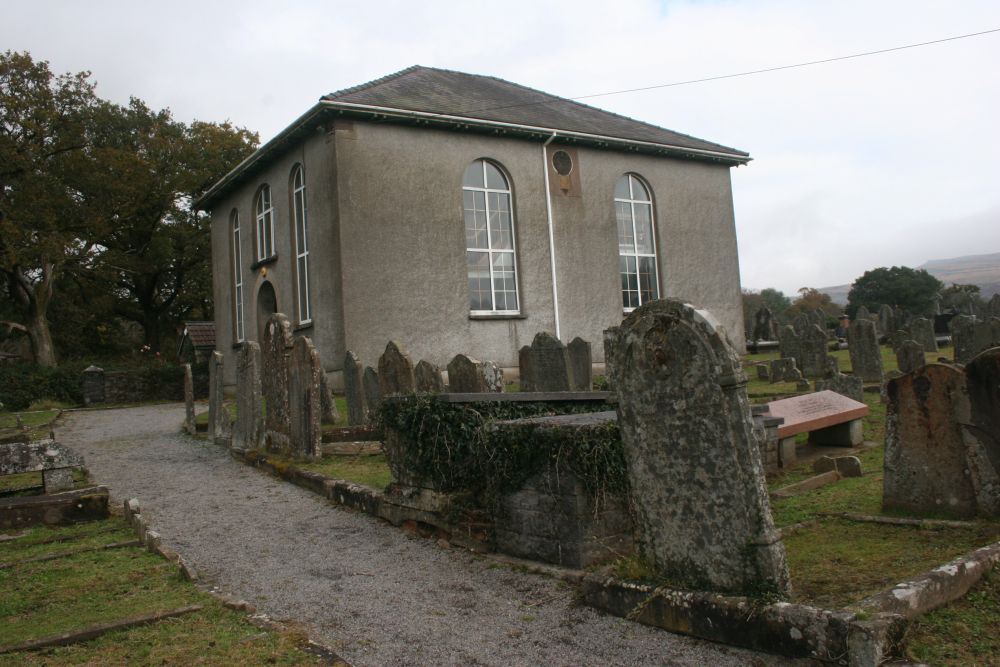
On the right-hand side of the pathway between the gate and the chapel, the Watkins family grave is one of the horizontal rectangular tombs. The inscription on the side of the tomb reads as follows :-
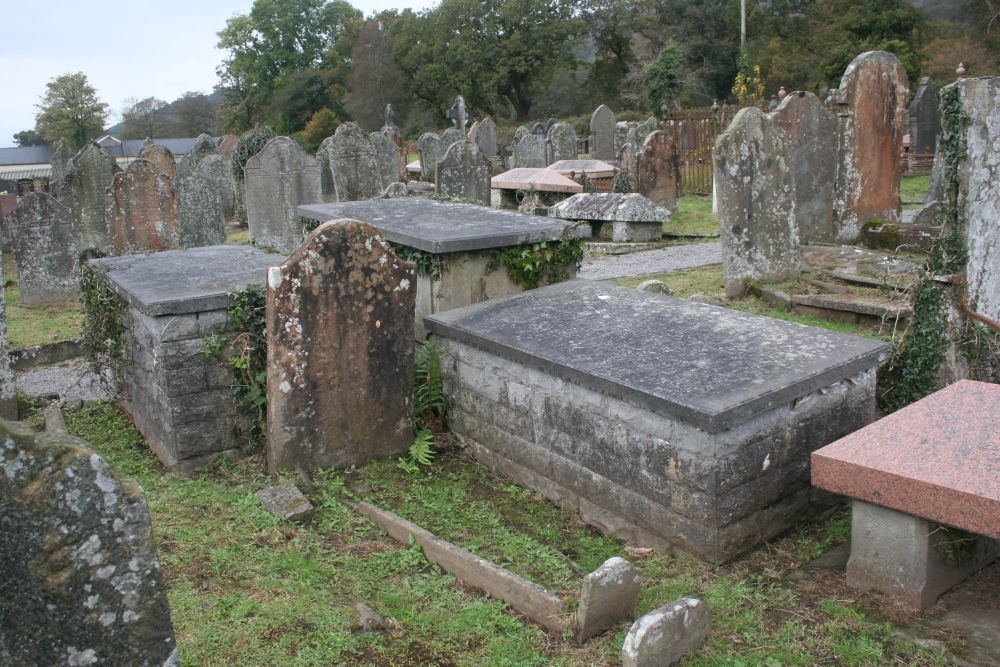
Left Side:-
Sacred to/the Memory of WILLIAM/ Son of Thomas Watkin/ of Gwarscwd in this Parish/ who died March 6th 1781/ Aged 6 Months/ Also MARY the Daughter/ of the above named who/ died November 19th 1781/ Aged 21 years/ Also MARGARET wife of/ the above named who died/ March 10th 1805/Aged 66 Years/ Likewise the above named/ THOMAS Watkin/ died/ September 15th 1827/ Aged 90 Years/ Also of the above named/ WILLIAM WATKIN/ of Tyr'mawr in this Parish/ who departed this life/ April 29th 1863/ Aged 81 Years/
Verses from Scripture
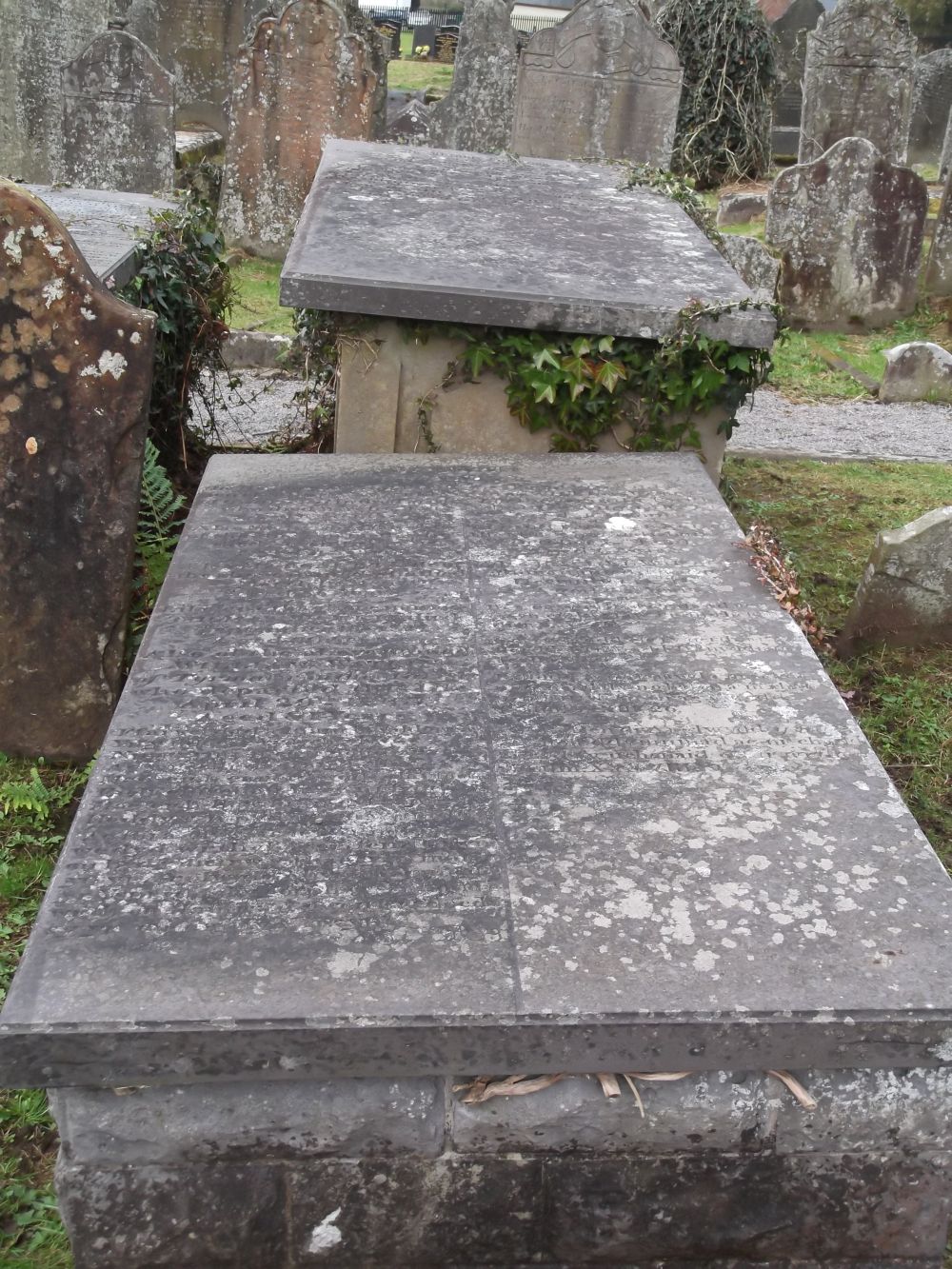
Right Side:-
Sacred to/the Memory of WILLIAM/ Son of William Watkins/ of Tyr'mawr in this Parish/ who died August 16th 1817/ Aged 4 Months/ Also of THOMAS Son of/ the above named who died October 6th 1820/ Aged 6 Years/ Also RACHEL wife of the/ above named who died/ December 15th 1853/ Aged 73 Years/
Verses from Scripture
Ystradgynlais - South Wales
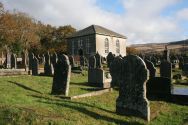
Email Yeargroup:
yeargroup@hotmail.co.uk
Email Wolfian Design:
webdesign@wolfianpress.com


















